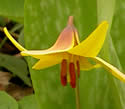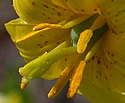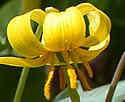Erythronium americanum (Yellow Trout Lily)
| Also known as: | Yellow Adder's-tongue, Dogtooth Violet |
|---|---|
| Genus: | Erythronium |
| Family: | Liliaceae (Lily) |
| Life cycle: | perennial |
| Origin: | native |
| Habitat: | part shade, shade; moist rich woods, thickets, along streams |
| Bloom season: | April - May |
| Plant height: | 4 to 8 inches |
| Wetland Indicator Status: | none |
| MN county distribution (click map to enlarge): |  |
| National distribution (click map to enlarge): |  |
Pick an image for a larger view. See the glossary for icon descriptions.
Detailed Information
Flower: 
![[photo of flower]](/udata/r9ndp23q/yellow/erythronium-americanum-yellow-trout-lily_0508_135847-t.jpg) A single, nodding flower at the end of a stiff naked stalk 4 to 7 inches (10 to 18 cm) long. Flowers have 6 lance-elliptic tepals (3 petals and 3 similar sepals) ¾ to 1 1/3 inch (20 to 33 mm) long, yellow sometimes tinged purplish on the outer surface and/or have reddish dots in the throat. There are 6 long stamens in the center, usually with deep rusty red tips (anthers), or sometimes yellow. Flowers open in the morning, the tepals flaring out and back, and close up at night.
A single, nodding flower at the end of a stiff naked stalk 4 to 7 inches (10 to 18 cm) long. Flowers have 6 lance-elliptic tepals (3 petals and 3 similar sepals) ¾ to 1 1/3 inch (20 to 33 mm) long, yellow sometimes tinged purplish on the outer surface and/or have reddish dots in the throat. There are 6 long stamens in the center, usually with deep rusty red tips (anthers), or sometimes yellow. Flowers open in the morning, the tepals flaring out and back, and close up at night.
Leaves: 

![[photo of leaves]](/udata/r9ndp23q/yellow/erythronium-americanum-yellow-trout-lily_0508_140131-t.jpg) Leaves are all basal, flowering plants with a pair of leaves and non-flowering plants with one. Leaves are lance-elliptic to oval to egg-shaped, 3 to 9 inches (to 23 cm) long, to 2 inches wide, toothless, hairless, tapering at both ends, on a slender stalk that arises from an underground bulb, most bulbs not producing flowers. Color is waxy blue-green irregularly mottled with purplish brown, the mottling typically fading with age.
Leaves are all basal, flowering plants with a pair of leaves and non-flowering plants with one. Leaves are lance-elliptic to oval to egg-shaped, 3 to 9 inches (to 23 cm) long, to 2 inches wide, toothless, hairless, tapering at both ends, on a slender stalk that arises from an underground bulb, most bulbs not producing flowers. Color is waxy blue-green irregularly mottled with purplish brown, the mottling typically fading with age.
Fruit: 
Fruit is a capsule, oval to inverted egg-shaped, rounded at the tip end, about ½ inch (12 to 15 mm) long at maturity, usually held erect. Reproduction by non-flowering plants is via stolons (horizontal stems), that are buried just below the surface and form a new bulb at the end, from which a new shoot emerges the following year.
Notes:
Leaves are very similar to Minnesota's other two Trout Lilies (E. albidum and E. propullans) though some of the images here were taken at Eloise Butler Wildflower Garden in Minneapolis, where both leaves with pale green mottling and flowers with yellow anthers were on display (the source of these plants is not known). Like the other Trout Lily species, the yellow is most common in rich woods and on flood plains, the leaves appearing by early April and completely gone by June, and can form large colonies. There are 2 recognized subspecies in North America: subsp. harperi, which has a limited range in a few southeastern states, has a minute point at the tip of a capsule; subsp. americanum has the rounded capsule described here and is found from the easternmost counties of Minnesota eastward and as far south as northern Alabama.
Native Plant Nurseries, Restoration and Landscaping Services ↓
More photos
 Yellow Trout Lily plants
Yellow Trout Lily plants Yellow Trout Lily plants
Yellow Trout Lily plants flowers with red spots and yellow anthers
flowers with red spots and yellow anthers a colony of Yellow Trout Lily
a colony of Yellow Trout Lily
Photos by K. Chayka taken in Winona County. Photos by Peter M. Dziuk, taken at Eloise Butler Wildflower Garden in Minneapolis and in Pine County.
Comments
Have you seen this plant in Minnesota, or have any other comments about it?
on: 2010-04-17 15:10:50
Found one in the woods about 15 feet off the dirt road in Deerwood, MN.
on: 2013-04-29 13:00:53
I seem to have these all over the edges of our yard! We just moved in the winter and now that the snow is gone, the muddy areas, near the woods, is blanketed with what looks like these lilies... sprouts of purple and green leaves everywhere. Can a person plant grass seed amongst these? I'm sure the flowers are nice, but we would honestly rather have grass. Thanks in advance for any help on the matter!
on: 2016-04-30 15:07:26
A nice burst of color on a gray day. These lilies are along the wood and pasture line. This is my first citing of them.
on: 2016-05-04 23:50:13
Good population at the East end of woodlands on the site of the 1800's city of Chengwatana along the Snake River.
on: 2017-04-24 16:16:25
What I had assumed would be E. albidum at a wildflower site in the MN River valley appears to be rather E. americanum, with a few yellow blooms just beginning to open at this time.
on: 2017-09-30 08:44:07
Small colony seen in the midst of huge colonies of Dutchman's Breeches on an elevation that floods only occasionally in the spring.
on: 2020-05-16 15:08:46
Seen blooming in the woods behind the cabin.
on: 2020-05-23 09:56:08
Huge beautiful area next to quiet stream.
on: 2021-04-18 21:30:03
Found some at Beaver Creek Valley State park today. April 18.
on: 2021-04-30 11:14:46
I have the leaves of this plant growing in my backyard woods - no blooms yet. Second year of seeing the leaves.
on: 2022-06-29 09:55:54
There are thousands of Yellow Trout Lilies throughout the woods in my neighborhood near Chester Creek, and a large number are in the woods towards the south end of my yard that's not far from the creek.






